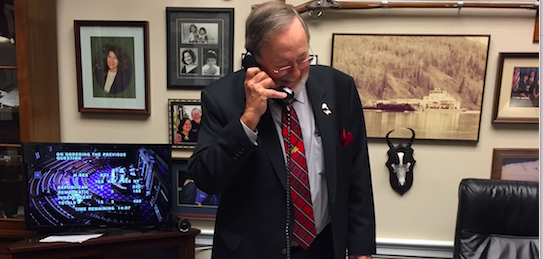By CONGRESSMAN DON YOUNG
Energy production and its role in driving climate change — very rightfully — is as important a topic as ever.
While the United States leads the way in developing energy in significantly cleaner ways than Russia, Venezuela, and China, Democrats continue to promote a policy agenda that would cripple our economy and cause energy prices to skyrocket for Americans.
This month, Democrats on the House Natural Resources Subcommittee on Energy and Mineral Resources held a hearing on their latest virtue-signaling messaging effort: Net-Zero Emissions.
Their goal, while well-intentioned – is to implement a federal mandate to achieve net-zero emissions by the year 2050.
For those not well-versed in left-wing policymaking, “net-zero” means that once all greenhouse gas emissions from humans are eliminated, the remaining emissions will be removed from the atmosphere by natural and artificial sinks.
How do Democrats plan on getting us to net-zero? Through unrealistic and unattainable mandates that will only harm average Americans.
What happens if we end all fossil fuel development as House Democrats and their leading presidential candidates propose? First and foremost, the destruction of the 10.3 million jobs directly and indirectly supported by the oil and gas sector. In fact, some of my Democrat colleagues have proposed pie-in-the-sky legislation that would eliminate cars, air travel, and even meat. Yes, meat.
Additionally, they have called for the elimination of nuclear energy and natural gas, two energy resources that have helped the U.S. lower our emissions.
Finally, pursuing net-zero in the manner prescribed by Democrats would cause American household energy bills to skyrocket.
House Democrats are 10 months into their majority, and they are still only offering unrealistic promises instead of actual solutions.
We do need to reduce our emissions and lead by example for other nations that have lower environmental standards than the U.S. But we don’t need to resort to mandates and trillion-dollar spending plans to do this.
A truly all-of-the-above American energy approach – not net-zero – is what’s needed to reduce emissions and protect our environment. To that end, I’ve been happy to work with colleagues on both sides of the aisle to explore and support renewable energy resources.
Alaska is home to vast amounts of streams, rivers, and other waterways, and we should harness these resources to strengthen our hydropower production. Hydropower is clean, renewable, and sends exactly zero emissions into our atmosphere. Last Congress, I authored legislation to expedite the Terror Lake Hydroelectric Project on Kodiak Island. Alaskans are strong proponents of renewable resources, and my legislation, which was signed into law, has helped Kodiak reach its ambitious goal of receiving 99 percent of its energy from renewable sources.
Our country is rich with opportunities for hydropower, and to help achieve meaningful and realistic reductions of emissions, Congress should pursue new hydro projects and bolster support of existing ones. Alaskans are proud of Kodiak’s accomplishments, and with the right policies in place, we can use Kodiak as a model across the Lower 48.
Alaska can teach the rest of the country when it comes to finding renewable energy resources, all one needs to do is look in their back yard. With millions of acres of forests, Alaska has become home to many successful biomass projects. Biomass – which comes primarily from wood and sawmill waste, has helped a school in Tok displace 65,000 gallons of fuel oil per year.
It doesn’t stop there. In 2017, the City of Galena started operating their own biomass facility, displacing 200,000 gallons of fuel oil since their biomass operation went online. It’s a no-brainer for municipalities to pursue these renewable options, but it’s up to us to ensure that they have the support necessary to work in conjunction with traditional oil and gas.
Finally, the simple truth that radical environmentalists don’t understand is that oil will continue to play a role in reducing our emissions. Simply put, if America isn’t developing our oil resources, countries with lower environmental standards will.
Recently, House Democrats, many who have never even stepped foot in Alaska, voted to reverse the progress we made under the 2017 tax bill to open the 1002 Area of ANWR’s Coastal Plain to oil exploration.
I know Alaskans to be both good environmental stewards and responsible resource developers. Their work to make America energy independent is exactly what we need to break free of Chinese, Russian and Venezuelan oil. Alaska leads by example, and if the rest of the country follows, we won’t need the allure of empty promises to protect our planet.
The choices for America’s energy future are clear. We can find ourselves endlessly pursuing the unrealistic proposals put forth by liberal interests intent on placating their vocal base with the so-called net-zero and in the meantime kneecapping our economy and hurting communities across our country. Or we can recognize that an all-of-the-above approach including renewables allowed to operate on a level playing field with responsible oil development, is the most realistic option to cut emissions and empower states and municipalities to move into America’s energy future.
It’s incumbent on Congress to support policies to make this future a reality, and we must choose wisely.
Congressman Don Young is a member of the House Natural Resources Committee, for which he previously served as chair.

Back to bicycles, living in caves and eating raw meat. Neanderthal built fires for warmth. In 2050, things could get problematic for the wackos.